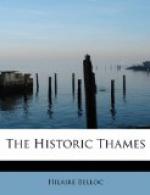The long and narrow parishes in the reaches below Benson, Nuneham Morren, Mongewell, and Ipsden and South Stoke are not, however, examples of this tendency.
They owe their construction to the same causes as have produced the similar long parishes of the Surrey and the Sussex Weald. The life of the parish was in each case right on the river or very close to it, and the extension is not the attempt of the parish to reach the river, but the claim of the parish upon the hunting lands which lay up behind it upon the Chiltern Hills. The truth of this will be apparent to anyone who notes upon the map the way in which parishes are thus lengthened, not only on the western side of the hills, but also upon the farther eastern side, where there was no connection with the river.
There are many other proofs remaining of the chief function which the Thames fulfilled in the early part of our history as a means of communication.
We shall see later in these pages how united all that line of the stream has been; how the great monasteries founded upon the Thames were supported by possessions stretched all along the valleys; how much of it, and what important parts, were held by the Crown; and how strong was the architectural influence of towns upon one another up and down the water, as also how the place names upon the banks are everywhere drawn from the river; but before dealing with these it is best to establish the main portions into which the Thames falls and to see what would naturally be their limits.
It may be said, generally, that every river which is tidal, and whose stream is so slow as to be easily navigable in either direction, divides itself naturally, when one is regarding it as a means of communication, into three main divisions.
There will first of all be the tidal portion which the tide usually scours into an estuary. As a general rule, this portion is not considerably inhabited in the early periods of history, for it is not until a large international commerce arises that vessels have much occasion to stop as they pass up and down the maritime part of the stream; and even so, settlements upon its banks must come comparatively late in the development of the history of the river, because a landing upon such flooded banks is not easily to be effected.
This is true of the Dutch marshes at the mouths of the Rhine, whose civilisation (one exclusively due to the energy of man) came centuries after the establishment of the great Roman towns of the Rhine; it is true of the estuary of the Seine, whose principal harbour of Havre is almost modern, and whose difficulties are still formidable for ocean-going craft; and it is true of the Thames.
The estuary of the Thames plays little or no part in the very early history of England. Invaders, when they landed, landed on the sea-coast at the very mouth, or appear to have sailed right up into the heart of the country.




